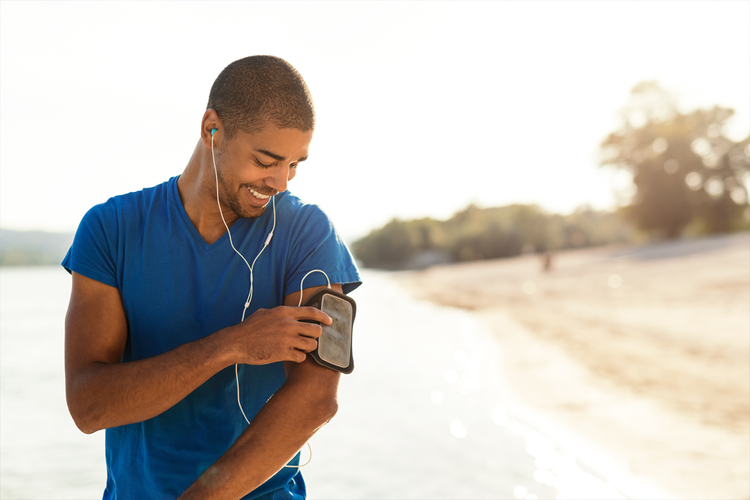What Headphones Should You Wear While Exercising?

An expert from JVC weighs in on this workout accessory.
Music for your workout can be like coffee in the morning—some of us can’t live without it.
Music is motivating. It provides a steady tempo for running—or lifting. It can transform your mindset or help you focus.
Wearing headphones while working out can enhance that focus by blocking out distractions. But what types of headphones should you use? We asked Jeff Marks, general manager of the marketing communications division at JVC, for an expert perspective on the features and functionality of different headphone options.
Headphone classification
- In-ear headphones: Anything that fits snugly within the inner ear canal
- Buds: Inner-ear headphones that don’t go all the way into the ear canal (think Apple/iPhone buds)
- On-ear: Banded, outer-ear headsets (think airplane headphones)
- Over-the-ear: Big cans (headphones that completely enclose the ear, rather than resting on the outside) that cancel out outside noise
How they rank
On or over-the-ear
Marks would not recommend on-ear and over-the-ear headphones for exercising. They tend to be bulky in size and don’t stay put. That said, the outer-ear headphones have the best fidelity (sound quality). So if you are going to use them for a low-impact activity—like lifting—he would recommend wireless, Bluetooth cans, so the cords don’t get in the way. However, these are typically the most expensive option ($300 as opposed to $30-$80 wireless in-ears).
In-ear and buds
The bud style offer some sports models with nozzle tips, which helps the buds stay in your ear. The in-ear style and bud style also have a hook option that goes behind your ear. (The problem with over-the-ear hooks, however, is they don’t offer a lot of adjustability—if you wear glasses or a hat there can be irritation.)
Marks says the premium version of in-ear headphones has a pivot motion fit, or a “fin,” that allows the user to put that fin or pivot point in the pinna of the ear (the flaps inside your ear). The fin acts as a little hook that allows the headphones to stay in your ear. This is the most secure type of headphone for a very wide range of people.
“We can fit probably 95 percent of the people that try on our headphones with the fin headset,” says Marks. “People can’t try on inner ear headphones anywhere, so if you’re looking for a go-to, go for the fin type. It’s the most flexible and most versatile.”
Why fit matters
Fit affects:
- Sweat pooling in your ear canal. If the headphones aren’t snug, sweat can slip in.
- Fidelity—or sound quality. You need a tight seal to hear good bass.
- A snug fit. This keeps the headphones in your ears and from slipping out.
“Usually, headphones come with a few sizes of ear tips and the key is to have a snug fit that changes the way you hear. If it doesn’t change, the music isn’t filling your inner ear,” Marks says.
For safety reasons, most in-ear headphones will also offer various-sized tips with appropriated holes to let in ambient noise—specifically for those working out outside. And while this will affect sound and music quality, it will also allow runners, cyclists and anyone worried about traffic or their surroundings to be more aware and alert.
Water proof, sweat proof or washable?
When people exercise, they sweat. (Duh.) So you definitely want headphones that are waterproof (can be submerged for certain length of time at certain depth), sweat-proof (sport), or washable (can be cleaned out under water pressure) adds Marks.
You should also clean your headphones regularly, as they tend to build up bacteria. (You sweat, throw them in your gym bag, then put them back in your ears—that’s a lot of bacteria!) Washable and waterproof headphones make cleaning your earbuds that much easier. A little soap and water should do the trick.
Wireless vs. wired
Nowadays, everyone wants Bluetooth—and for good reason. Long wires tend to get in the way while running, biking, lifting and so on. And of course, headphones with the option for volume and track forward/back control on the wire are ideal. However, for Bluetooth, “You should also take battery power into consideration,” adds Marks. (JVC sells Bluetooth headphones with up to 16 hours of battery time.)
The takeaway
“The best recommendation for most people most of the time are the sweat-proof (maybe washable/water-proof), wireless or wired in-ear headphones, that let you have control of your music via buttons, and that offer you a variety of different sized and types of tips, with pivot motion/fins for optimum fit,” concludes Marks. And the best part? These headphones won’t break the bank. (They typically start at around $30 and go as high as $80.)
Don’t have a great pair of headphones? Or did you make it to the gym but left your headphones at home? Or maybe you’re not sure you want to drop $80 on a pair of headphones just yet. Pick up a more affordable, colorful pair of JVC in-ear headphones at 24 Hour Fitness’ retail area, and go get your sweat on.
Rock on!
What does the future of how we listen to music look like? And how do you build a great playlist?
Photo credit: bernardbodo, Thinkstock